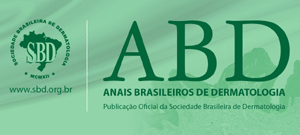Resumo em Inglês:
BACKGROUND: Mycosis fungoides, the most common subtype of cutaneous T-cell lymphoma, is more common in patients aged 45-55. OBJECTIVE: Cardiovascular risk factors have been investigated in several skin diseases. However, the relation between cardiovascular diseases and mycosis fungoides remains unclear. Therefore, the aim of this study was to assess cardiovascular risk factors in patients with mycosis fungoides. METHODS: 32 patients with mycosis fungoides and 26 healthy controls were enrolled in the study. Glucose, total cholesterol, high-density lipoprotein cholesterol, triglyceride, homocystein, high sensitivity C-reactive protein, low-density lipoprotein – cholesterol, were measured in the sera of patients. RESULTS: Patients had significantly higher high-sensitivity C-reactive protein, homocysteine, low-density lipoprotein - cholesterol, total cholesterol (p= 0.032) (p< 0.001) (p= 0.001) (p< 0.001). There was a positive correlation between the levels of homo-cysteine and total cholesterol (p= 0.001, r = +0.431). Additionally, a significantly positive correlation was found between the levels of high-sensitivity C-reactive protein and low-density lipoprotein - cholesterol (p= 0.014, r = +0.320) in patient group. CONCLUSIONS: Patients with mycosis fungoides had significantly higher levels of total-cholesterol, low-density lipoprotein -cholesterol, homocysteine and high-sensitivity C-reactive protein than healthy subjects. The present study has demonstrated an increased rate of cardiovascular risk in patients with mycosis fungoides. Even though the etiology of these associations is elusive, dermatologists should be sensitized to investigate metabolic derangements in patients with mycosis fungoides, in order to lessen mortality and comorbidity with a multidisciplinary approach.
